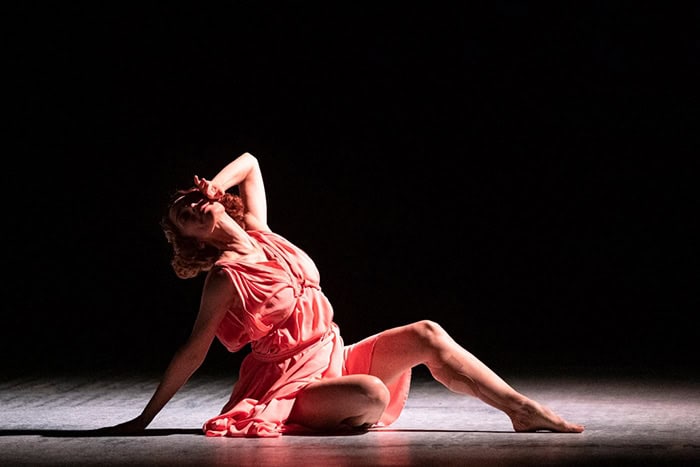Viviana Durante Company in Isadora Now at the Barbican
Posted: March 12th, 2020 | Author: Nicholas Minns | Filed under: Performance | Tags: Anna Geniushene, Barbara Kane, Begoña Cao, Camille Andriot, Farook Chaudhry, Isadora Duncan, Joy Alpuerto Ritter, Lih Qun Wong, Lynn Seymour, Marius Petipa, Mikhail Fokine, Sir Frederick Ashton, Viviana Durante, Yang Liping | Comments Off on Viviana Durante Company in Isadora Now at the BarbicanViviana Durante Company, Isadora Now: A Triple Bill at the Barbican, February 27

Viviana Durante Company’s triple bill, Isadora Now, sets out to explore the impact of Isadora Duncan on dance. The program by the all-female ensemble is part of the Barbican’s 2020 season Inside Out, which ‘will showcase the work of artists who have found pioneering ways to articulate their innermost thoughts, feelings and desires…’ As Durante writes in the program, ‘Isadora Duncan was a pioneer of modern dance, an outsider who spurned the conventions and gendered roles of classical ballet and insisted on a woman’s right to express herself physically on her own terms.’ When Duncan performed in St. Petersburg in 1904, her freedom of movement presented a revelatory contrast to the classical works of the Imperial Ballet’s principal ballet master and choreographer, Marius Petipa. After almost forty years in this position, Petipa was coming to the end of his career, and in this creative interregnum a young Mikhail Fokine was searching for a new choreographic form. In Duncan’s dancing he believed he had found the plasticity he sought, and set about adapting it for his early works, most noticeably in Chopiniana (later renamed Les Sylphides). A seventeen-year-old Frederick Ashton saw Duncan dance in 1921 and was similarly struck by her expressiveness, returning to see her night after night. Fifty-five years later he set down his memories in his Five Brahms Waltzes in the Manner of Isadora Duncan, which he created on Lynn Seymour. Marie Rambert, who had also been overwhelmed by Duncan’s dancing, is said to have cried when she saw Seymour perform the work because the experience was so close to what she remembered.
Memory is at the heart of Isadora Now, with a difference: nobody involved in the project has ever seen Duncan dance. The first piece on the program — Dance of the Furies from Gluck’s opera Orfeo ed Euridice that Duncan had choreographed as a solo in 1911 — is a reconstruction by Barbara Kane for five dancers. Kane has devoted her life to studying Duncan’s style of dance which has been handed down through generations of Duncan dancers and teachers, though the genealogy of this staging is not explained in the program. As interesting as it is formally, what is missing is an understanding of how Duncan’s spirit might have informed the steps; it is in the nature of historical reconstruction that we shall never know.
Durante is on firmer ground with Ashton’s Five Brahms Waltzes, in that both Seymour and Durante have been steeped in the Royal Ballet’s Ashton style and repertoire, and both have been recognised as the most gifted dramatic dancers of their respective generations. There are two grainy films of Seymour dancing the work that nevertheless offer an opportunity to see how she embodied what Ashton created on her. Durante was coached in the role by Camille Andriot rather than by Seymour but unless you saw her performance on the opening night you would have missed her interpretation on subsequent evenings due to injury. Her role is taken by Begoña Cao, a former principal dancer with English National Ballet, and although her extensive credits do not include works by Ashton, she gives an inspired interpretation of the work to the piano accompaniment of Anna Geniushene.
Five Brahms Waltzes forms a bridge in the program between Duncan and the present. It’s a span of over a hundred years in which the emancipation of women has become a political reality in many, but not all parts of the world. Having written in 1903 that ‘she [the dancer of the future] shall dance the freedom of woman’, what kind of presence would Duncan have if she were alive today, and in the context of Isadora Now, what kind of dance would she embody? Durante leaves the answer to her co-producer, Farooq Chaudhry, who defers instead to his creative contacts. Chaudhry is the long-time producer and co-founder of Akram Khan Company and is also International Creative Producer for the Chinese choreographer, Yang Liping. Joy Alpuerto Ritter, his choice to choreograph the final work of the evening, has been a dancer and rehearsal director for Khan since 2013 and her composer/musician on this occasion is cellist, Lih Qun Wong, who has worked with Yang Liping. The Chaudhry network further co-opts the culmination of Isadora Now by employing a raft of creatives from both companies. Ritter’s work, Unda, fails to emerge ‘on its own terms’ from this chauvinistic influence, while her deference to Duncan’s style maintains a historical distance from a contemporary evaluation of Isadora now.